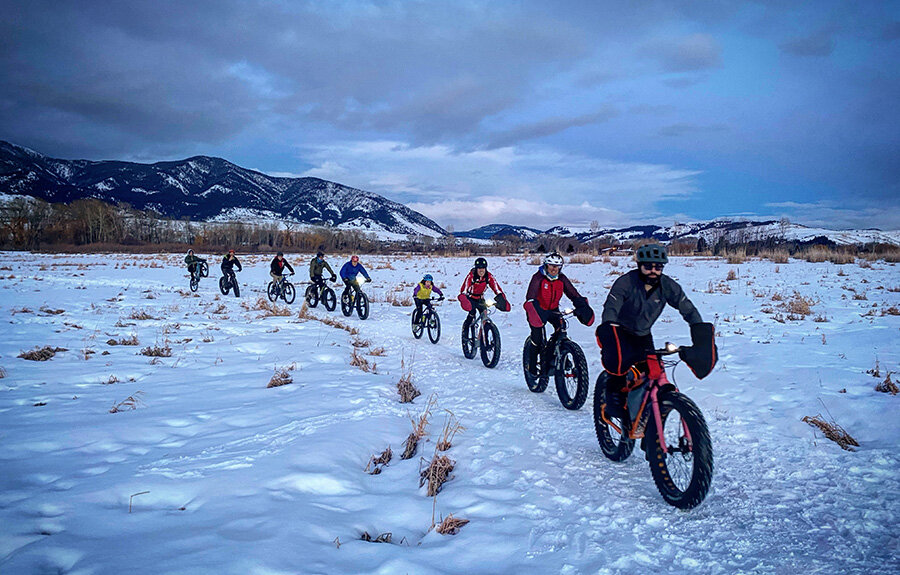Southwest Singletrack: Roll 'Em Fat
A SWMMBA group ride at Cherry River, February 2021. Photo by David Tucker.
Winter cycling in southwest Montana
By Brandon Campisi
Snow has returned to the valley and it’s finally starting to feel like winter is on the way. This year, after you get back from your desert escapes, don’t put the bikes away for good. Get out on a fatbike and check out all the options southwest Montana has to offer.
Before you do, consider these tips.
Clothing
If you are warm when you start, you will likely be too hot in a short amount of time. Dress in layers and have a place to put them as you add and subtract. Dress like you will be Nordic skiing, snowshoeing, or participating in any other high-output activity. Mitigating sweat is the key to staying warm. Once you are wet, the only way to stay warm is to trap the sweat with a waterproof layer.
I often wear 2-3 layers on top even if it is -20 degrees. I’ll wear Nordic pants by themselves until the temp is below 10. Lower than that, you’ll find me around a fire with a good cup of Mile Creek tea, unless I’m competing in something like JP’s Fat Pursuit.
Hands & Feet
Hands and feet are the touch points when it comes to fatbiking. I recommend gloves based on hand temperature ratings, or Pogies for extreme cold or those with poor circulation. Revelate, 45NRTH, Wolftooth, and Bar Mitts all make quality products. Check out local dealers like REI, Owenhouse, and Bangtail. Winter boots from 45NRTH, Lake, or Sidi are also great to have, but they’re expensive. If boots are too costly or if your commitment to winter cycling is pretty casual, thick neoprene shoe covers or winter boots on flat pedals work great.
Headwear
Wear a helmet. It will keep you warmer, and it will protect your dome on variable snow and ice and rocks lurking just beneath the surface. Wear a headband that keeps your ears warm but allows heat to escape, or wear a thin hat when the temps really dip.
Tire Pressure
Tire pressure is the key to successful fatbiking. Fifteen PSI is the highest you ever want to run. This should only be run on snow that is hard-packed. Tubeless riders can run as low as 3 PSI on less packed, softer snow. If the front tire is washing out, drop pressure. If you can’t get traction in the rear, drop pressure. If tubeless, you can ride a flat tire on soft snow if you have to. Adjusting pressure up and down on longer rides is common.
Trails to Try
Start out around town. Check out Glen Lake Rotary Club Park—aka East Gallatin Rec—and connect that system to Cherry River, or out to the M. Most of the trails at Highland Glen are groomed for Nordic skiing in the winter, but there is a new multi-use trail connecting the Hyalite View trail to the Painted Hills trail, both of which are open to bikes. As conditions allow, it is possible to ride from Main Street out to Triple Tree.
Beyond Bozeman, popular singletrack that doesn’t receive much snow is rideable for much of the year with the right tires. The primary access challenge will be road conditions, so be prepared with the necessary self-rescue equipment. Forest Service roads like Storm Castle and Battle Ridge can be enjoyable, but both are heavily used by snowmobilers. If you are accessing these roads, you will need a Resident Trails Pass.
While the trails in Hyalite that are groomed for Nordic skiing are not open to bikes, Moser Road, which is also groomed, is open to bikes. Some singletrack that sees a lot of foot traffic, like the Hyalite Creek trail, also makes for a fun day on a fatbike.
Misc
Bring water as you will be sweating and need to rehydrate. Hydration hoses freeze and winter tube sleeves don’t work. Water bottles freeze at extreme lows, but valves can freeze even in moderate cold. Electrolyte drinks don’t freeze except at extreme lows. Bring foods that don’t freeze. Have a pump to adjust tire pressure. Have a multitool as temperature can affect bolt tension on many components. Bring a buff or similar as a dry back up for your neck and/or head.

